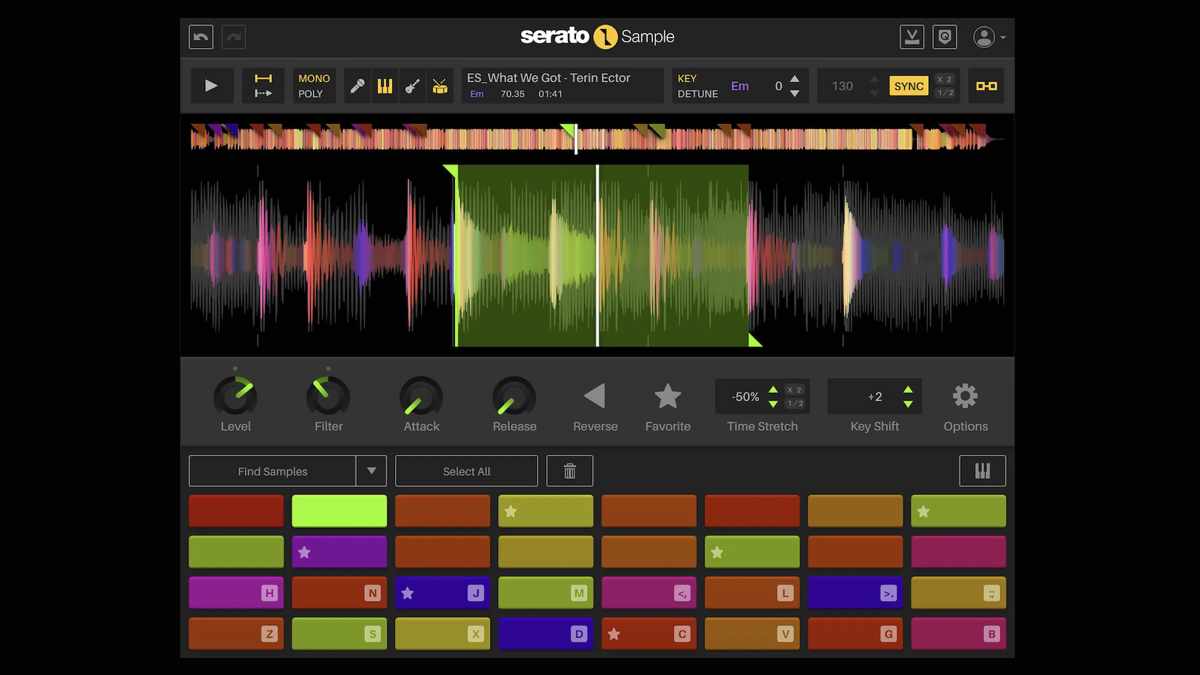In This Issue
Serato Sample 2.0 Plug-In – the Synth and Software Review

Grab samples from a mix, and even separate the vox, instruments, bass, and drums
There’s mixing, remixing, and now in Serato’s new Sample 2.0 plug-in, de-mixing: separating the vocals, drums, instruments, and bass into individual stems. You can then trigger the stems in any combination, either by MIDI or by clicking on buttons in the interface.
Serato’s first product back in the ’90s was Pitch ‘n Time (it’s still available), which as its name implies lets you change the pitch and tempo of a full mix independently. Many of their current products include that, and it’s in Sample.
But the main idea behind Sample is making it easy to cut samples out of recordings of all kinds – and it continues to be very good at that. For live performance, DJs love to have the software show the tempo and key signature in real time, and Sample does that. You can also click the Sync button and it plays at the current tempo of your DAW.
Digging into stem separation.
Based on my previous experience with stem separation, I expected Sample to take quite a while to analyze the song I dragged in. The process of separating the various parts of a song is complex, and software with the ability to do that has always been slow and heavily taxing on the CPU.
Sample 2.0’s analysis took literally seconds. Once it was finished, the four buttons in the GUI (microphone, keyboard, bass guitar, and drums) were illuminated, and you can then turn them on or off individually.
I could imagine a scenario in which it would be nice to solo the drums while you crossfade into a new song, and then bring the other parts in as you fade out the previous song – in other words, creating perhaps and 8- or 16-bar bar percussion-only “handle” at the beginning. Right this minute your brain is probably racing through all creative uses for this feature.
So here’s the $64,000 question: how does it sound?
Well, it’s not perfect. But no stem separation that exists can deliver perfect stems as if they were came from the original multitrack recording.
In the past, production students have asked me if it was possible to mute or isolate a single element of a mix (usually vocals), or if reverb could be muted altogether. The answer was always no, that it’s like asking to remove the egg yolks from a cake after it’s baked.
But over time the answer has changed to “maybe,” and I expect that it will become an unequivocal “yes” in the future. Today this technology is still in its infancy, and the quality it can produce is not quite perfect.
The compromise here is doing this in real time. Maybe if the Sample 2.0 algorithm were given hours and hours to grind away at the file, it could produce better results. But the magic of this plug-in is that it yields very usable results very quickly – so quickly that it’s useful for live performance.
Serato Sample has always made it easy to slice a sample out of something, but now we can slice a sample out of individual parts. Again, these separated stems may have some artifacts, but they’re still very usable. And sometimes they were so clean that you’d think they came from the original multitrack, regardless of the styles and eras – from Elvis to Pharrel Williams.
Once separated, there’s a grid of colored buttons to trigger the samples you’ve cut out. And of course the samples can be triggered by MIDI (usually from a keyboard).
It’s a great time to be alive – technology is delivering abilities that were once only a dream – and the expectation is that it’s only going to keep getting better. Serato Sample 2.0 is a perfect example of this kind of progress – very much worth looking at if you need this kind of tool.
Price: $149 (also available by subscription)















